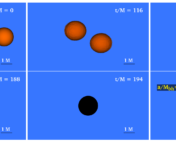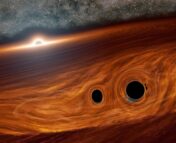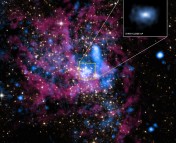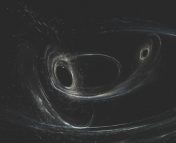Authors: B. McKernan, K.E.S. Ford, T. Callister, W.M. Farr, R.O’Shaughnessy, R.Smith, E. Thrane & A.Vajpeyi
First Author’s Institution: Department of Science, City University of New York
Paper Status: Submitted to MNRAS [open access on arXiv]
We do care about AGNs!
It is widely accepted that active galactic nuclei (AGN) are powered by the release of gravitational energy as mass falls onto a supermassive black hole (SMBH) in the center of AGN via accretion (look at Figure 1). There are also other, not so massive, black holes (BHs) dynamically moving inside the AGN disks. These dynamical interactions between black holes and the disks they’re embedded into might lead some of the black holes to merge or form binaries, and, what’s even more fascinating, these merger events are observed by LIGO–Virgo through gravitational waves signals! Ok…not specifically these events are observed by the LIGO-Virgo collaborations. Rather, they detect gravitational waves signals from any black hole mergers (they don’t really care if they’re in AGNs or not), but we can map the mergers that we see onto AGN disks and see if we get the same results!
Phenomergology (phenomenology of BH mergers)
The authors of today’s paper try to understand some properties of these black holes. Breaking down the long, and a bit complicated, the title of the paper, LIGO-Virgo observations suggest correlation (or anti-correlation) exists between black holes mass ratios and their spins (the direction in which the black holes spin around their axes), so the authors discuss these observations using simulations.
Using 48 binary black holes (BBH) mergers from the O3a catalog, a previous study indicates that binary black holes’ mass ratios and effective spins are anti-correlated: unequal-mass black holes tend to have positive effective spins while equal-mass black holes have small or vanishing effective spins. The goal of today’s paper is to establish the phenomenological conditions required in order to generate the same anti-correlation using in Monte Carlo simulations of BBH mergers in AGN disks.
Monte Carlo’s theory of Natural Selection
Considering the observational results, the authors analyzed their Monte Carlo simulations adding some assumptions based on phenomenological considerations. The authors of the paper define prograde and retrograde binaries as shown in Figure 1. Prograde binaries rotate in the same direction as the AGN disk around an SMBH, retrograde binaries rotate in a different direction.
The first obvious step in understanding the BBH mergers in AGN disks would be just to use the Monte Carlo simulation, forgetting that LIGO-Virgo even exists and remembering about them only after you get the results. The authors of the paper did just that and found no anti-correlation that was observed by LIGO-Virgo. This would make you think that you need to change something in your simulations! What they actually changed was suppressing some types of BBH mergers. More precisely: negative effective mass mergers (the direction of the spin of individual BHs is not the same as the direction of the spin of the binary), which basically just led to suppressing retrograde binaries. They also suppressed too small mass ratio + too small effective spins binaries and too big mass ratio + too big effective spin binaries, because anti-correlation actually depends on a more massive object in the binary and the way it is spinning.
Don’t forget about the gas!
Another major ingredient in the analysis of BBH mergers in AGN disks is…well, the disk itself. The disk is mostly gas, and, as it turns out, this gas plays an important role! It can push the constantly moving black holes to be together (“hardening”) or, on the contrary, separate them from each other (“softening”). Another important consideration is the way it can break the symmetry. Classical dynamical merger channels (e.g., globular clusters and nuclear star clusters) generally assume spherical symmetry. However, the AGN disks tend to break spherical mass symmetry in a galactic nucleus because of a number of reasons that are discussed in the paper: the parallel alignment of angular momenta of the binaries and of the disk makes the encounters move into co-planar arrangements; there may be regions in the inner disk where migration stalls (e.g., migration traps), so BBHs would merge typically at the outer disk (far away from the center), which can even happen not on the plane of the disk; BHs orbiting the SMBH on retrograde orbits may rapidly decay onto the SMBH, biasing orbits to prograde; more massive BHs are more quickly captured by the AGN disk and will therefore spend more overall time in the disk, spinning up and trying to align with the disk; and many other reasons.
Did they get what they wanted?
The answer to the section’s question is YES! They did! Considering all the above-mentioned ingredients in the recipe they finally found the desired anti-correlation.
This study actually shows a very interesting thing in astrophysics: all fields are connected. Unknowingly, researchers in gravitational wave astronomy helped to understand AGNs better and, which is (fun fact) also true for planet formation researchers!
Astrobite edited by: Alex Pizzuto
Featured image credit: James R. Eads and Chris McDaniel




